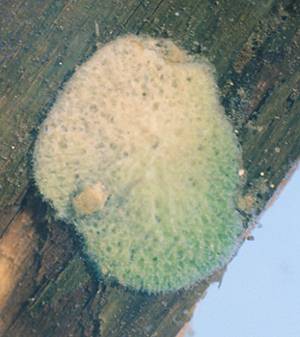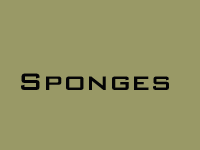|
Sponges
 The
earliest sponge fossils date back to the Vendian, about 600 million years
ago. They have often been important reef-builders, at many times as important
as all other reef-building organisms combined, but today they only play
a minor part in the construction of reefs. Sponge diversity reached a
high point in the Cretaceous, when dinosaurs reached their largest size. The
earliest sponge fossils date back to the Vendian, about 600 million years
ago. They have often been important reef-builders, at many times as important
as all other reef-building organisms combined, but today they only play
a minor part in the construction of reefs. Sponge diversity reached a
high point in the Cretaceous, when dinosaurs reached their largest size.
Sponges are the most primitive
of the multicelled animals. They lack organs, but have several different
cell types and are built around a system of water canals; water is pulled
through these canals and filtered for food. Small structures called spicules
provide support for the body, and classification is based on the material
and structure of the spicules. Almost all sponges are marine.
Five thousand species of sponges
have been identified, and there may be five thousand more. The three classes
of sponges are the Calcarea (glass sponges), Hexactinellida (silicious
sponges), and Demospongiae. Canada contains about five hundred species
of sponges.
 Anheteromeyenia argyrosperma
Anheteromeyenia argyrosperma
 Anheteromeyenia
biceps Anheteromeyenia
biceps
 Anheteromeyenia
pictouensis Anheteromeyenia
pictouensis
 Anheteromeyenia
ryderi Anheteromeyenia
ryderi
 Corvomeyenia
carolinensis Corvomeyenia
carolinensis
 Corvomeyenia
everetti Corvomeyenia
everetti
 Corvospongilla
becki Corvospongilla
becki
 Corvospongilla
novaeterrae Corvospongilla
novaeterrae
 Dosilia
palmeri Dosilia
palmeri
 Dosilia
plumosa Dosilia
plumosa
 Dosilia
radiospiculata Dosilia
radiospiculata
 Ephydatia
fluviatilis Ephydatia
fluviatilis
 Ephydatia
japonica Ephydatia
japonica
 Ephydatia
millsii Ephydatia
millsii
 Ephydatia
muelleri Ephydatia
muelleri
 Ephydatia
robusta Ephydatia
robusta
 Eunapius
igloviformis Eunapius
igloviformis
 Eunapius
mackayi Eunapius
mackayi
 Eunapius
fragilis Eunapius
fragilis
 Heteromeyenia
baileyi Heteromeyenia
baileyi
 Heteromeyenia
latitenta Heteromeyenia
latitenta
 Heteromeyenia
tentasperma Heteromeyenia
tentasperma
 Meyenia
sp. Meyenia
sp.
 Radiospongilla
cerebellata Radiospongilla
cerebellata
 Radiospongilla
crateriformis Radiospongilla
crateriformis
 Spongilla
aspinosa Spongilla
aspinosa
 Spongilla
cenota Spongilla
cenota
 Spongilla
heterosclerifera Spongilla
heterosclerifera
 Spongilla
lacustris Spongilla
lacustris
 Spongilla
alba Spongilla
alba
 Stratospongilla
penneyi Stratospongilla
penneyi
 Trochospongilla
horrida Trochospongilla
horrida
 Trochospongilla
leidii Trochospongilla
leidii
 Trochospongilla
pennsylvanica Trochospongilla
pennsylvanica
|


